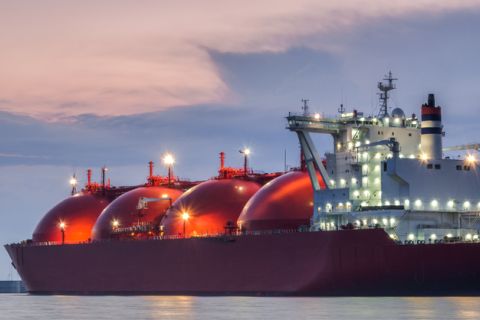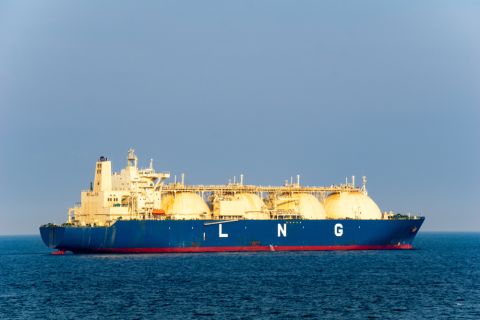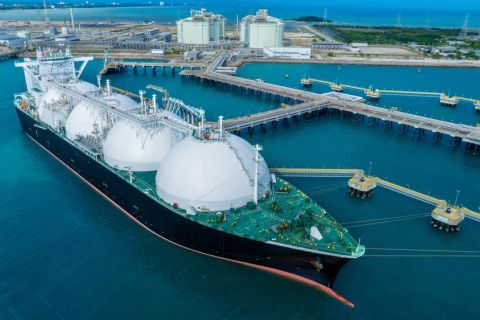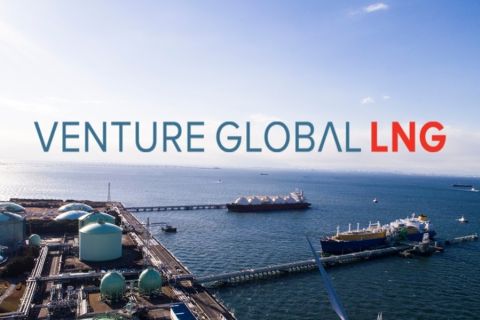Presented by:

Editor's note: This article appears in the E&P newsletter. Subscribe here.
Oilfield water management continues to be a growing sector of the oil and gas industry, but with drought concerns and the rise of seismicity in one of the largest oil producing regions in the U.S., produced water management is facing the same scrutiny that the whole industry is facing in regard to concerns over ESG.
As the industry has leaned away from the use of freshwater, we are still consuming brackish water. Although brackish water is not a source of drinking water, it is the next closest available source for communities facing drought conditions. If these drought conditions continue, these communities may have to consider desalination of the available brackish water, which we have been consuming.
This drives the necessity to focus on produced water recycling, especially when more than double the water needed is produced in the form of produced water. There are also concerns the industry is inducing seismicity when disposing of the water.
It is not as simple, though, as just recycling all of the produced water. There are land owner restrictions or agreements that force operators to use fresh or brackish water. In New Mexico they developed legislation that makes these types of agreements void if they are restricting or preventing the recycling of produced water, but outside of New Mexico these issues continue to exist.
Then there are logistical issues. Produced water may not be where a company is completing new wells.
In addition, there is the issue of a reliable well completions schedule. Recycled produced water needs a well completion as an outlet for the recycled product. When a completion schedule isn’t consistent, this requires sufficient disposal capacity to manage the produced water.
Additionally, a company avoids planning large recycle facilities when its return on investment is questionable because it can’t guarantee its use of the recycled product. The company is generating scale in the recycling program and reducing costs, but it cannot commit to scale when the utilization is questionable because of an unreliable completions schedule.
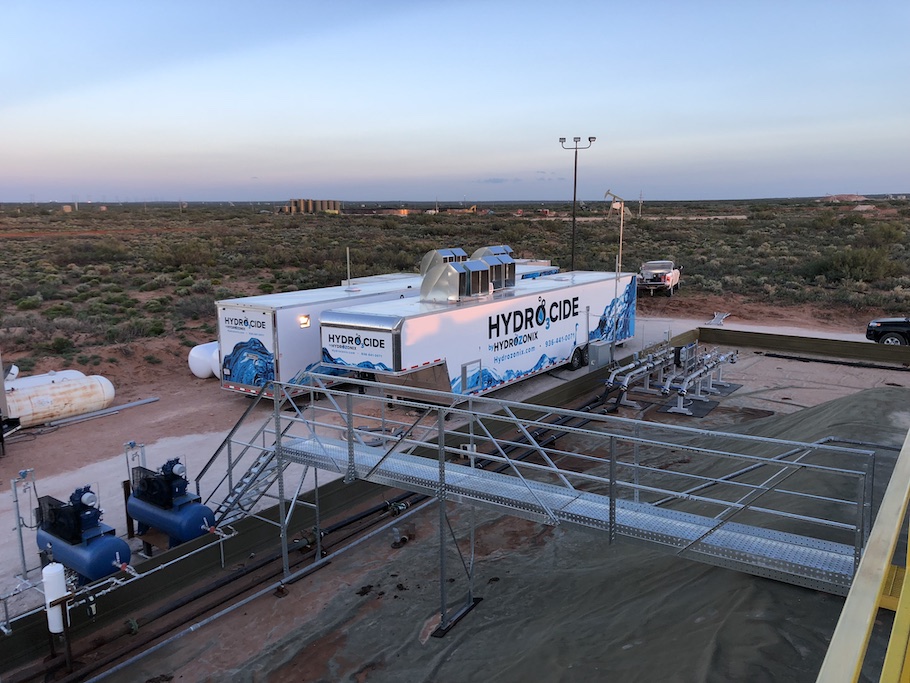
A fully automated HYDRO3CIDE is shown at a 60,000- to 80,000-bbl/d recycling facility in New Mexico. (Source: Hydrozonix)
Recycling produced water
As simple as recycling produced water might sound, it can be a very complex issue. But no one will argue that produced water recycling is a critical metric that needs to be monitored to satisfy the industry’s ESG focus.
Recycling should be encouraged as much as possible. But is all recycling the same?
When considering the need for an improved ESG profile, the common question is always at what cost?
Hydrozonix has deployed its HYDRO3CIDE, fully automated ozone system, at 15 recycling facilities across the Permian Basin. At five of these facilities, the company has utilized its automation to develop completely unmanned produced water recycling facilities, with total capex and opex costs under $0.10/bbl.
By utilizing the HYDRO3CIDE system, users are generating ozone on site using the surrounding air as the raw material. This is a sustainable approach. Users no longer are driving and delivering chemical totes from manufacturers to distributors and then to the field, significantly reducing the carbon footprint.
Users are also eliminating chemical spills or other risks from chemical storage. They are also no longer producing chlorinated byproducts, which are formed from using chlorinated oxidizers.
By unmanning the recycling facilities, the daily truck trips for field operators and the carbon footprint are reduced even further.
As much as companies need to increase their recycling of produced water, the larger concern is the overall produced water management program, which consists of primarily produced water recycling and disposal wells, both of which are challenged by inconsistent completion schedules (and with disposal wells, exclusively induced seismicity).
Produced water management is two options—or a two-legged stool, which isn’t to stable. A third leg is needed for the produced water management stool. Today that is quickly becoming evaporation; tomorrow it may become desalination.

The HYDRO3CIDE system is shown at Guidon Energy's 25,000-bbl/d facility. (Source: Hydrozonix)
Reducing flaring emissions
Another ESG concern the industry faces in flaring.
HYDROFLARE, patented in 2019, is a flare emission scrubbing system that reduces emissions from flaring by using a wet scrubber technology while evaporating produced water.
The system can be combined with the HYDRO3CIDE ozone system to reduce NOx form flare emissions by more than 90%.
Salts are accumulated in the system and can be removed as a pumpable slurry or further dewatered for a drier solid.
HYDROFLARE addresses many ESG concerns: creating produced water management capacity, reducing disposal intensity, reducing emissions from flaring and putting water back into the hydrologic cycle.
Optimizing evaporation
Unfortunately, flare gas and produced water aren’t always located in the same area, and combining flare gas and produced water may not always be available. So are there other options?
Conventional surface evaporation, although used in many other industries, is problematic for produced water management. The salt dust created from the evaporation is spread to the adjacent land contaminating it with a salt dust having the same impact of a produced water spill in regard to increasing the salinity of the soil to make it agriculturally unsuitable.
HYDRO-Vap is a fully automated system that monitors and adjusts multiple variables to control salt deposition and keep salt dust within the confines of the produced water impoundment or pit. The design utilizes a new nozzle design that limits salt drift, while monitoring multiple variables to optimize evaporation while minimizing the salt drift.
Evaporation is becoming the third leg of the produced water management stool allowing produced water management to become more stable. The two-legged stool used by many operators requires either unused disposal capacity that is set aside to address for the uncertainty in completion schedules in the environment or the use of third-party disposal at a higher cost. Evaporation provides the additional outlet needed to provide the stability the industry needs for a successful produced water management strategy.
RELATED CONTENT:
July 30, 2021 Recycling Produced Water in Completed Development Areas
July 29, 2021 Oil and Gas Investor: Water Management
July 22, 2021 B3 Insight Launches New Oilfield Water ESG Council
July 21, 2021 NGL Energy Partners Completes Initial Delaware Basin Wastewater Recycling Project
July 8, 2021 Texas Tech Heads Collaboration to Study Impact, Technology for Recycling Produced Water
Recommended Reading
Biden Totters the US LNG Line Between Environment, Energy Security
2024-01-30 - Recent moves by U.S. President Joe Biden targeting the country’s LNG industry, which has a number of projects in the works, are an attempt to satisfy environmentalists ahead of the next upcoming presidential election.
EQT’s Toby Rice: US NatGas is a Global ‘Decarbonizing Force’
2024-03-21 - The shale revolution has unlocked an amazing resource but it is far from reaching full potential as a lot more opportunities exist, EQT Corp. President and CEO Toby Rice said in a plenary session during CERAWeek by S&P Global.
Watson: Implications of LNG Pause
2024-03-07 - Critical questions remain for LNG on the heels of the Biden administration's pause on LNG export permits to non-Free Trade Agreement countries.
GOP’s Reaction to White House LNG Pause Takes Shape
2024-01-31 - The U.S. House Energy, Climate and Grid Security subcommittee set the date for a hearing on the Biden administration’s recent pause on LNG export approvals for Feb. 6; Republican Louisiana Sen. John Kennedy pledges to block Biden nominees.
Venture Global Seeks FERC Actions on LNG Projects with Sense of Urgency
2024-02-21 - Venture Global files requests with the Federal Energy Regulatory Commission for Calcasieu Pass 1 and 2 before a potential vacancy on the commission brings approvals to a standstill.

